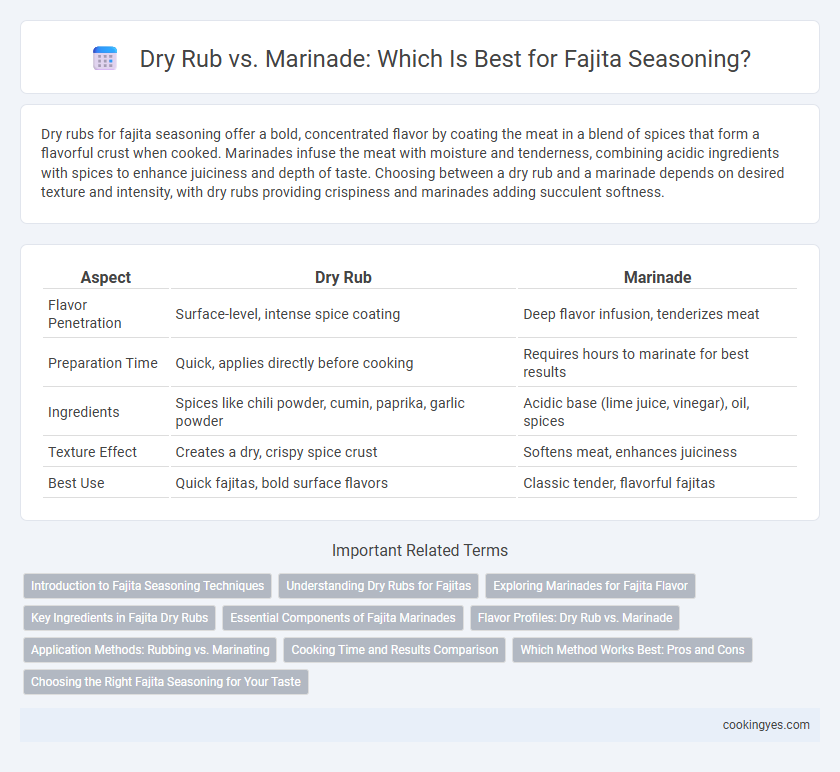Dry rubs for fajita seasoning offer a bold, concentrated flavor by coating the meat in a blend of spices that form a flavorful crust when cooked. Marinades infuse the meat with moisture and tenderness, combining acidic ingredients with spices to enhance juiciness and depth of taste. Choosing between a dry rub and a marinade depends on desired texture and intensity, with dry rubs providing crispiness and marinades adding succulent softness.
Table of Comparison
| Aspect | Dry Rub | Marinade |
|---|---|---|
| Flavor Penetration | Surface-level, intense spice coating | Deep flavor infusion, tenderizes meat |
| Preparation Time | Quick, applies directly before cooking | Requires hours to marinate for best results |
| Ingredients | Spices like chili powder, cumin, paprika, garlic powder | Acidic base (lime juice, vinegar), oil, spices |
| Texture Effect | Creates a dry, crispy spice crust | Softens meat, enhances juiciness |
| Best Use | Quick fajitas, bold surface flavors | Classic tender, flavorful fajitas |
Introduction to Fajita Seasoning Techniques
Fajita seasoning techniques vary primarily between dry rubs and marinades, each offering distinct flavor profiles and cooking benefits. Dry rubs, composed of ground spices like cumin, chili powder, and paprika, create a concentrated crust that enhances the meat's natural taste during grilling. Marinades, typically combining acidic ingredients such as lime juice or vinegar with spices, tenderize the meat while infusing it with complex, layered flavors essential for authentic fajitas.
Understanding Dry Rubs for Fajitas
Dry rubs for fajitas consist of a blend of spices such as chili powder, cumin, paprika, garlic powder, and salt, which are directly applied to the meat to create a flavorful crust during cooking. This seasoning method enhances the natural texture of the proteins while intensifying the smoky and spicy notes crucial to traditional fajitas. Unlike marinades, dry rubs do not add moisture but instead form a concentrated flavor layer that caramelizes on high heat, delivering a robust and authentic taste experience.
Exploring Marinades for Fajita Flavor
Marinades for fajita seasoning infuse meat with deep, complex flavors by combining acidic ingredients like lime juice or vinegar with spices such as cumin, chili powder, and garlic. The acidic component tenderizes the meat while the spices penetrate, enhancing juiciness and overall taste. Using a marinade allows the flavors to develop over time, resulting in a more vibrant and well-rounded fajita experience compared to a dry rub.
Key Ingredients in Fajita Dry Rubs
Fajita dry rubs commonly feature a blend of key ingredients such as chili powder, cumin, smoked paprika, garlic powder, onion powder, and salt, creating a bold, smoky flavor profile. These spices adhere directly to the meat, enhancing the natural taste without adding moisture, resulting in a more concentrated seasoning. Using a dry rub simplifies preparation and intensifies the fajita's signature spicy and savory notes.
Essential Components of Fajita Marinades
Fajita marinades typically include essential components such as acid, oil, and a blend of spices like cumin, chili powder, and garlic to tenderize and infuse the meat with robust flavors. The acid, often lime juice or vinegar, breaks down proteins for enhanced tenderness, while oil ensures even distribution of spices and moisture retention. Incorporating fresh ingredients like cilantro and jalapenos in the marinade elevates the complexity and authentic taste of traditional fajitas.
Flavor Profiles: Dry Rub vs. Marinade
Dry rubs for fajitas create a bold, concentrated flavor by coating the meat with a blend of spices like chili powder, cumin, and paprika, which intensifies the natural taste through direct contact. Marinades infuse the meat with moisture and complex layers of flavor, combining acidic ingredients like lime juice or vinegar with herbs and spices for a tender, juicy result. Choosing between dry rub and marinade depends on desired texture and flavor depth, with dry rubs delivering a robust, smoky profile and marinades providing a zesty, well-rounded taste.
Application Methods: Rubbing vs. Marinating
Dry rubs for fajitas involve directly applying a blend of spices onto the meat, creating a flavorful crust that enhances texture through caramelization during grilling. Marinades combine acids, oils, and seasonings, allowing the meat to soak and tenderize over time, resulting in more evenly infused flavors. Choosing between rubbing and marinating depends on desired infusion depth and texture, with dry rubs offering a quick application and marinades requiring longer preparation.
Cooking Time and Results Comparison
Dry rubs for fajitas require less preparation time as they can be applied directly before cooking, resulting in a bold, concentrated flavor and a slightly crispy texture. Marinades need at least 30 minutes to several hours to infuse the meat with moisture and deeper flavor profiles, producing juicier and more tender fajitas. Choosing between dry rub and marinade depends on desired cooking time and final texture, with dry rub offering quicker seasoning and marinade enhancing tenderness.
Which Method Works Best: Pros and Cons
Dry rub fajita seasoning offers intense, concentrated flavors that adhere well to the meat's surface, creating a flavorful crust when grilled, while marinades infuse deeper moisture and tenderness by breaking down proteins over time. Dry rubs require less preparation time and maintain a firmer texture, but may lack internal flavor penetration, whereas marinades need longer marinating periods and can result in a softer, juicier bite. Choosing between dry rubs and marinades depends on desired texture, flavor depth, and available marinating time for the perfect fajita experience.
Choosing the Right Fajita Seasoning for Your Taste
Choosing the right fajita seasoning depends on flavor intensity and preparation time. Dry rubs offer a concentrated, robust taste that easily adheres to meat, enhancing the natural flavors without added moisture. In contrast, marinades infuse deeper, more complex flavors while tenderizing meat, ideal for those seeking a juicy, well-seasoned fajita experience.
Dry rub vs Marinade for fajita seasoning Infographic

 cookingyes.com
cookingyes.com